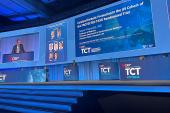Strike Two: BHF PROTECT-TAVI Throws Cold Water on Embolic Protection
Experts are dismayed, disappointed, and confused, but many say this isn’t the end of cerebral embolic protection for TAVI.

CHICAGO, IL—A large-scale, randomized trial testing routine cerebral embolic protection during TAVI has once again failed to show the device reduces the risk of stroke.
The British Heart Foundation’s BHF PROTECT-TAVI trial, which was presented today as a late-breaking clinical trial at the American College of Cardiology (ACC) 2025 Scientific Session and published in the New England Journal of Medicine, comes 18 months after PROTECTED TAVR failed to show that embolic protection reduced the risk of stroke.
The two trials, which in combination include more than 10,000 randomized patients, have left operators scratching their heads about why the device, which does capture dislodged emboli during TAVI, failed to demonstrate any clinical benefit.
“We undertook a subgroup analysis to understand whether there's any difference by subgroups. We looked at groups [stratified] by age, sex, bicuspid valve anatomy, clinical risk score, by self-expanding or balloon-expanding [valve type], or the extent of aortic valve calcification,” said BHF PROTECT-TAVI lead investigator Rajesh Kharbanda, MBChB, PhD (Oxford University Hospitals NHS Foundation Trust, England), during a morning press conference.
In no group, he said, could they find a treatment benefit. “This trial testing the routine use of cerebral embolic protection during TAVI does not confirm any evidence of reduction in the risk of stroke,” said Kharbanda.
Speaking in the press conference, S. Chris Malaisrie, MD (Northwestern University Feinberg School of Medicine, Chicago, IL), said that while cerebral embolic protection makes intuitive sense, the clinical data don’t back the concept up.
“The interesting thing in the United States is that the device got approved based upon solely the fact that it was able to capture material in the basket, which is a compelling reason,” said Malaisrie. “It's better in the basket than in the brain, for sure. I think all of us are disappointed that the two big trials now have failed to show a benefit in the clinical endpoint of stroke, and [it] leads us to wonder where we're going to go from here with cerebral protection.”
He further questioned whether an improved design might yield better outcomes down the road, but even that’s open for debate. “I just hope that these negative trials don't put breaks on further iterations of this technology,” said Malaisrie.
I just hope that these negative trials don't put breaks on further iterations of this technology. S. Chris Malaisrie
Jay Giri, MD (University of Pennsylvania Perelman School of Medicine, Philadelphia, PA), who wasn’t involved in BHF PROTECT-TAVI, said that he has used embolic protection in approximately 75% of TAVI cases in recent years, a percentage he expects to decline given these data. But, one positive takeaway from the trial results is that there was no signal of harm from using embolic protection.
“That made me feel a little better that I didn't put a lot of patients at risk over the years,” he told TCTMD. “Unfortunately, it does appear that we may have potentially spent a lot of time and money on an intervention that doesn't have clear clinical efficacy.”
David Cohen, MD (St. Francis Hospital, Roslyn, NY, and Cardiovascular Research Foundation, New York, NY), another structural interventionalist who wasn’t involved in the study, said the results of the two trials are disappointing for patients and physicians.
“It also points to the challenges of evaluating these devices,” Cohen told TCTMD. “Everyone would think that capturing debris, which it definitely does in many patients, would prevent stroke every single time and that it would be easy to show a benefit. These two trials together have shown how difficult that is.”
The US Food and Drug Administration approved the embolic protection device in 2017 on the basis on the SENTINEL IDE trial. That trial missed its primary endpoint—new brain lesion volume on MRI was not significantly lower with embolic protection—but FDA reviewers felt the device made intuitive sense, noting that it reduced new lesion volume in protected territories and that embolic debris was captured in nearly every procedure.
For Giri, one of the key messages from both studies is that “surrogate endpoints are just not enough to guarantee clinical efficacy.”
Pragmatic BHF Trial
BHF PROTECT-TAVI was a pragmatic trial that included 7,635 participants (mean age 81.2 years; 38.7% women) with aortic stenosis randomized to undergo TAVI with cerebral embolic protection (Sentinel; Boston Scientific) or TAVI without the device.
The procedure was performed at 32 National Health Service hospitals and a single private practice, with the study capturing approximately 30% of all TAVIs performed in the United Kingdom. Investigators estimated that the incidence of stroke with and without embolic protection would be 2% and 3%, respectively, and the trial was stopped for futility following a blinded analysis from the data monitoring committee.
Routine use is hard to justify in 2025. David Cohen
Stroke within 72 hours of TAVI or before discharge occurred in 2.1% of patients assigned to embolic protection and 2.2% of patients treated without the device (RR 0.99; 95% CI 0.73 to 1.34). The rate of severe stroke occurred in 0.5% of patients in both groups.
Disabling stroke within 6 to 8 weeks after TAVI occurred in 1.2% of patients treated with embolic protection and 1.4% of those in the control group (RR 0.89; 95% CI 0.60-1.31). This nonsignificant result differs from PROTECTED TAVR where the rate of disabling stroke was significantly lower with embolic protection, a finding that led to some reticence on the part of operators to give up on the device.
Complications and adverse events were low with Sentinel and similar between the treatment and control arms.
Samir Kapadia, MD (Cleveland Clinic, OH), who led PROTECTED TAVR, questioned the rate of device success in the British trial. Both filters were successfully deployed in 81.2% of patients randomized to embolic protection, with at least one filter (proximal or distal) fully deployed in 87.5% of patients. In their trial, however, the device was deployed successfully in 95% of attempts.
“They have a fairly large number of patients who did not get the device,” Kapadia told TCTMD. While intention-to-treat is the gold standard for randomized trials, “it’s important to understand what happened to the people who got the device versus those who did not,” he said.
This question emerged during the late-breaking session, with discussant Ajay Kirtane, MD (NewYork-Presbyterian/Columbia University Irving Medical Center, New York, NY), pressing Kharbanda on the rate of stroke in those who were randomized to embolic protection but did not receive the filter.
In response, Kharbanda said the rate of device success reflects routine clinical practice at busy TAVI centers, adding that they used a strict definition of successful deployment. As for the stroke rate in patients randomized to embolic protection but couldn’t get the device, Kharbanda said the stroke rate was around 4.0%.
However, he cautioned that any comparison of stroke in these patients against the control group is highly confounded. The intention-to-treat analysis, he stressed, is the gold standard in device trials and this should be the focus of BHF PROTECT-TAVI. The researchers did perform a “complier average causal effect” analysis to address nonadherence to the allocated treatment, and here the incidence of stroke and disabling stroke remained similar between the embolic protection and control groups, he said.
Overall, Kapadia remains “optimistic” about the use of embolic protection, adding that he continues to consistently use it.
“We have been using it in every patient for many years now,” he said. “In the last 4 years, our stroke rate is much less than 1% and major strokes [have not been] seen. We are satisfied with what we have been doing. The only reason to change something that we are doing is that we're convinced it is either harmful or totally not helpful.”
At this stage, he remains unconvinced that it holds no clinical benefit. Instead, BHF PROTECT-TAVI raises more questions than it answers, said Kapadia.
Is Embolic Protection Dead?
During an ACC media briefing, structural cardiologists were asked flat out if they thought embolic protection had flatlined in light of the two negative trials.
“I don't think the concept is dead,” said Kharbanda. “Stroke is still very clinically relevant, and we need to identify strategies that are going help us. We need to understand whether there are specific groups of patients that might benefit and that's going to need further trials. It might be that other devices offer different advantages that we need to test. Certainly, the clinical problem remains. We just need to find the right solution.”
To TCTMD, Giri said a deeper dive into the data might help the community understand the results better, including potential patients who could still benefit. He concedes that while operators will be looking for some signs of benefit, nothing really jumps out right now.
Surrogate endpoints are just not enough to guarantee clinical efficacy. Jay Giri
“You figure that the signal of a benefit would've been seen in the greater population and then maybe further exaggerated in these populations,” said Giri. If you’re not seeing a benefit in a large trial powered to detect a 0.8% absolute risk reduction in stroke, “it just leads you to believe that maybe the mechanism of action that you're going after, at least with this device, isn’t right.”
In 2024, Cohen, along with lead author Neel Butala, MD (University of Colorado Anschutz School of Medicine, Aurora, CO), and colleagues, published an analysis from the STS/ACC TVT Registry that showed embolic protection was associated with a borderline significant reduction in disabling stroke.
“The benefit was much smaller than anyone would have guessed,” Cohen told TCTMD. Based on power calculations, they concluded a trial would require anywhere from 97,000 to 132,000 randomized patients to show differences in the risk of in-hospital and disabling stroke, respectively. “The question then is: why is it so hard to show a benefit and if there is one, why is it much smaller than was hypothesized?”
Some thoughts include device pores that are too large to prevent strokes, that there isn’t a good seal around filter edges, and that there is incomplete protection (Sentinel protects two of the three main cerebral vessels), Cohen suggested. It’s also possible the device is causing as many events as it’s preventing.
“All of those [reasons] are possible,” said Cohen. “It’s a sobering reminder of why we need to do good clinical trials in order to find out what works.”
Declining Already in US
In the US, embolic protection use declined after PROTECTED TAVR and many expect it to decline further after BHF PROTECT-TAVI.
In one analysis of Medicare data, Giri said that as many as 30% of US hospitals are “margin negative” for TAVI—cutting embolic protection might help those centers at least get to neutral in terms of costs and reimbursement, he suggested.
“Routine use is hard to justify in 2025,” added Cohen.
However, he doesn’t suspect that it will drop to zero. “I think there will be people who feel that the embolic risk is so high that they really need to use something, even it’s not particularly effective,” Cohen said. “I do think [use] is going to drop further, and it’s probably appropriate given the evidence base to date.”
One potential area where cerebral protection might be used is in cases where operators need to modify the aortic leaflets, such as with the Basilica procedure or when using a leaflet splitter, Raj Makkar, MD (Cedars Sinai Medical Center, Los Angeles), told the media. In those scenarios, there can be quite a bit of embolic debris released into circulation.
Giri said that physicians can use the data from the two trials to have better conversations with patients during the consent process. “That would enable you to say, ‘The reason we’re not using [embolic protection] is because we know it doesn’t change things,’” he said.
Michael O’Riordan is the Managing Editor for TCTMD. He completed his undergraduate degrees at Queen’s University in Kingston, ON, and…
Read Full BioSources
Kharbanda RK, Kennedy J, Jamal Z, et al. Routine cerebral embolic protection during transcatheter aortic-valve implantation. N Engl J Med. 2025;Epub ahead of print.
Disclosures
- Kharbanda reports grants from Boston Scientific and speaker fees from Edwards Lifesciences and Medtronic.
- Kapadia reports serving as principal investigator of studies sponsored by Boston Scientific without financial conflict.
- Giri reports serving as advisor to Edwards and Boston Scientific.
- Cohen reports receiving grant support from or holding research contracts with Abbott Vascular, Boston Scientific, Edwards Lifesciences, Corvia, Ancora, Philips, Therox, and Brain Q and receiving a consultant fee or honoraria from Abbott Vascular, Boston Scientific, Edwards Lifesciences, Medtronic, Ancora, and Corvia.






Rod Stables
John Carroll